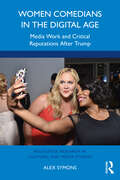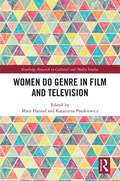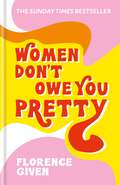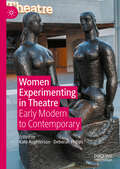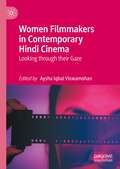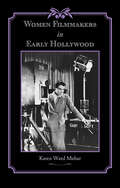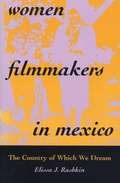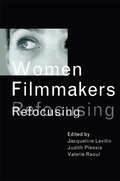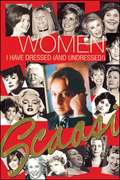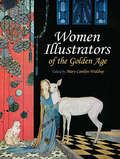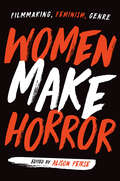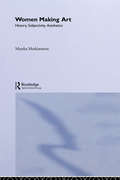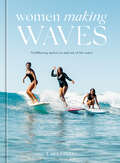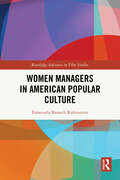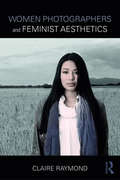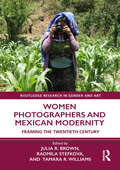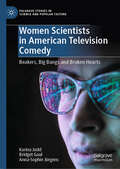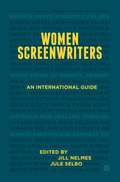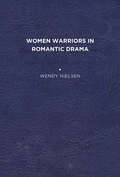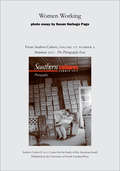- Table View
- List View
Women Comedians in the Digital Age: Media Work and Critical Reputations After Trump (Routledge Research in Cultural and Media Studies)
by Alex SymonsThis book offers a thorough examination of digital work by women comedians in the US, exploring their use of digital media to perform jokes, engage with fans, remake their reputations, and become political activists. This book argues that despite its many adverse effects, digital work is changing comedy, empowering women to create new comic forms and negotiate the contentious political climate incited by former President Donald. J. Trump. Chapters are focused on video podcasting, TikTok, Twitter, Instagram, YouTube, and the streaming platform Netflix – each containing informative case studies on significant women comedians who use them, including Sarah Silverman, Amy Schumer, Leslie Jones, Mindy Kaling, Colleen Ballinger, Lilly Singh, Ms. Pat, Whitney Cummings, Issa Rae, and others. To understand their strategies, this book examines the popularity of their digital content, their career outcomes in television and film, as well as the ups and downs of their critical reputations in magazines, newspapers, the trade press, and with their participatory audiences online. This insightful and timely work will appeal to scholars researching and teaching in the areas of media studies, digital communication, gender studies, and performance.
Women Do Genre in Film and Television (Routledge Research in Cultural and Media Studies)
by Katarzyna Paszkiewicz Mary HarrodThis volume examines how different generations of women work within the genericity of audio-visual storytelling not necessarily to ‘undo’ or ‘subvert’ popular formats, but also to draw on their generative force. Recent examples of filmmakers and creative practitioners within and outside Hollywood as well as women working in non-directing authorial roles remind us that women are in various ways authoring commercially and culturally impactful texts across a range of genres. Put simply, this volume asks: what do women who are creatively engaged with audio-visual industries do with genre and what does genre do with them? The contributors to the collection respond to this question from diverse perspectives and with different answers, spanning issues of direction, screenwriting, performance and audience address/reception.
Women Don't Owe You Pretty: The debut book from Florence Given
by Florence Given'THE BEAUTY MYTH' FOR THE INSTAGRAM GENERATIONWomen Don't Owe You Pretty is the ultimate book for anyone who wants to challenge the out-dated narratives supplied to us by the patriarchy.Through Florence's story you will learn how to protect your energy, discover that you are the love of your own life, and realise that today is a wonderful day to dump them.Florence Given is here to remind you that you owe men nothing, least of all pretty.WARNING: CONTAINS EXPLICIT CONTENT (AND A LOAD OF UNCOMFORTABLE TRUTHS). THE FEMINIST BOOK EVERYONE IS TALKING ABOUT.'An incredible mouthpiece for modern intersectional feminism.' - Glamour'A fearless book.' - Cosmopolitan 'A hugely influential young woman.' - Woman's Hour 'Rallying, radical and pitched perfectly for her generation.' - Evening StandardThis audiobook was recorded from home in May 2020. (P)2020 Octopus Publishing Group
Women Don't Owe You Pretty: The record-breaking best-selling book every woman needs
by Florence Given'THE BEAUTY MYTH' FOR THE INSTAGRAM GENERATIONWomen Don't Owe You Pretty is the ultimate book for anyone who wants to challenge the out-dated narratives supplied to us by the patriarchy.Through Florence's story you will learn how to protect your energy, discover that you are the love of your own life, and realise that today is a wonderful day to dump them.Florence Given is here to remind you that you owe men nothing, least of all pretty.WARNING: CONTAINS EXPLICIT CONTENT (AND A LOAD OF UNCOMFORTABLE TRUTHS). THE FEMINIST BOOK EVERYONE IS TALKING ABOUT.'An incredible mouthpiece for modern intersectional feminism.' - Glamour'A fearless book.' - Cosmopolitan 'A hugely influential young woman.' - Woman's Hour 'Rallying, radical and pitched perfectly for her generation.' - Evening Standard
Women Dramatists, Humor, and the French Stage
by Joyce JohnstonFilling a critical void, this book examines French women dramatists of the nineteenth century who managed to have their works staged prior to the lifting of censorship laws in 1864. Sophie de Bawr (1773 1860), Sophie Gay (1776 1852), Virginie Ancelot (1792 1875), and Delphine Gay de Girardin (1804 1855) all staged successful plays at Paris's top venues (Theatre Francais and Odeon) or at other selective theatres (Ambigu-Comique, Vaudeville, Gymnase) during this period without the aid or protection of a male coauthor. Between 1802 and 1855, all four of these dramatists were heavily involved in the literary scene of their day and hosted their own salons, venues essential for any male author wishing to see his works published and accepted among the public. While not always directly engaged in the politics of the day in their theater, these dramatists were aware of and influenced by the public sphere. Though none staged what today's critics would refer to as overtly feminist drama, through their use of humor, Bawr, Gay, Ancelot, and Girardin all cast aspersion upon patriarchal dominance and reconstructed ideals of womanhood that rejected traditional submissive roles. "
Women Experimenting in Theatre: Early Modern to Contemporary
by Deborah Philips Kate AughtersonThis collection of essays, covering a broad historical range, shows that women working in theatre and drama since the time of Aphra Behn have been engaged in pushing the boundaries of conventional representation and dramaturgical convention. Collectively the authors show that women have used performing spaces as a channel for both political and personal radicalism - one that has demanded and celebrated experimentalism as a kind of survival in a male dominated world.
Women Filmmakers in Contemporary Hindi Cinema: Looking through their Gaze
by Aysha Iqbal ViswamohanThis book is a comprehensive anthology comprising essays on women film directors, producers and screenwriters from Bollywood, or the popular Hindi film industry. It derives from the major theories of modernity, postmodern feminism, semiotics, cultural production, and gender performativity in globalized times. The collection transcends the traditional approaches of looking at films made by women filmmakers as ‘feminist’ cinema, and focuses on an extraordinary group of women filmmakers like Ashwini Iyer Tiwari, Bhavani Iyer, Farah Khan, Mira Nair Vijaya Mehta, and Zoya Akthar. The volume will be of interest to academics and theorists of gender and Hindi cinema, as well as anybody interested in contemporary Hindi films in their various manifestations.
Women Filmmakers in Early Hollywood (Studies in Industry and Society)
by Karen Ward MaharWomen Filmmakers in Early Hollywood explores when, how, and why women were accepted as filmmakers in the 1910s and why, by the 1920s, those opportunities had disappeared. In looking at the early film industry as an industry—a place of work—Mahar not only unravels the mystery of the disappearing female filmmaker but untangles the complicated relationship among gender, work culture, and business within modern industrial organizations.In the early 1910s, the film industry followed a theatrical model, fostering an egalitarian work culture in which everyone—male and female—helped behind the scenes in a variety of jobs. In this culture women thrived in powerful, creative roles, especially as writers, directors, and producers. By the end of that decade, however, mushrooming star salaries and skyrocketing movie budgets prompted the creation of the studio system. As the movie industry remade itself in the image of a modern American business, the masculinization of filmmaking took root.Mahar's study integrates feminist methodologies of examining the gendering of work with thorough historical scholarship of American industry and business culture. Tracing the transformation of the film industry into a legitimate "big business" of the 1920s, and explaining the fate of the female filmmaker during the silent era, Mahar demonstrates how industrial growth and change can unexpectedly open—and close—opportunities for women.
Women Filmmakers in Early Hollywood (Studies in Industry and Society)
by Karen Ward MaharA study of how and why women in early twentieth-century Hollywood went from having plenty of filmmaking opportunities to very few.Women Filmmakers in Early Hollywood explores when, how, and why women were accepted as filmmakers in the 1910s and why, by the 1920s, those opportunities had disappeared. In looking at the early film industry as an industry—a place of work—Mahar not only unravels the mystery of the disappearing female filmmaker but untangles the complicated relationship among gender, work culture, and business within modern industrial organizations. In the early 1910s, the film industry followed a theatrical model, fostering an egalitarian work culture in which everyone—male and female—helped behind the scenes in a variety of jobs. In this culture women thrived in powerful, creative roles, especially as writers, directors, and producers. By the end of that decade, however, mushrooming star salaries and skyrocketing movie budgets prompted the creation of the studio system. As the movie industry remade itself in the image of a modern American business, the masculinization of filmmaking took root. Mahar&’s study integrates feminist methodologies of examining the gendering of work with thorough historical scholarship of American industry and business culture. Tracing the transformation of the film industry into a legitimate &“big business&” of the 1920s, and explaining the fate of the female filmmaker during the silent era, Mahar demonstrates how industrial growth and change can unexpectedly open—and close—opportunities for women.&“With meticulous scholarship and fluid writing, Mahar tells the story of this golden era of female filmmaking . . . Women Filmmakers in Early Hollywood is not to be missed.&” —Samantha Barbas, Women&’s Review of Books&“Mahar views the business of making movies from the inside-out, focusing on questions about changing industrial models and work conventions. At her best, she shows how the industry&’s shifting business history impacted women&’s opportunities, recasting current understanding about the American film industry's development.&” —Hilary Hallett, Reviews in American History&“A scrupulously researched and argued analysis of how and why women made great professional and artistic gains in the U.S. film industry from 1906 to the mid-1920s and why they lost most of that ground until the late twentieth century.&” —Kathleen Feeley, Journal of American History&“Women Filmmakers in Early Hollywood offers convincing evidence of how economic forces shaped women&’s access to film production and presents a complex and engaging story of the women who took advantage of those opportunities.&” —Pennee Bender, Business History Review
Women Filmmakers in Mexico: The Country of Which We Dream
by Elissa J. RashkinWomen filmmakers in Mexico were rare until the 1980s and 1990s, when women began to direct feature films in unprecedented numbers. Their films have won acclaim at home and abroad, and the filmmakers have become key figures in contemporary Mexican cinema. In this book, Elissa Rashkin documents how and why women filmmakers have achieved these successes, as she explores how the women's movement, film studies programs, governmental film policy, and the transformation of the intellectual sector since the 1960s have all affected women's filmmaking in Mexico. <P><P> After a historical overview of Mexican women's filmmaking from the 1930s onward, Rashkin focuses on the work of five contemporary directors--Marisa Sistach, Busi Cortés, Guita Schyfter, María Novaro, and Dana Rotberg. Portraying the filmmakers as intellectuals participating in the public life of the nation, Rashkin examines how these directors have addressed questions of national identity through their films, replacing the patriarchal images and stereotypes of the classic Mexican cinema with feminist visions of a democratic and tolerant society.
Women Filmmakers: Refocusing
by Jacqueline Levitin Judith Plessis Valerie RaoulThis wide-ranging volume of new work brings together women filmmakers and critics who speak about what has changed over the past twenty years. Including such filmmakers as Margarethe von Trotta, Deepa Mehta, and Pratibha Parmar, and such critics as E. Ann Kaplan, this comprehensive volume addresses political, artistic, and economic questions vital
Women Holding Things
by Maira KalmanFrom the critically acclaimed artist, designer, and author of the bestsellers The Principles of Uncertainty and My Favorite Things comes a wondrous collection of words and paintings that is a moving meditation on the beauty and complexity of women’s lives and roles, revealed in the things they hold.“What do women hold? The home and the family. And the children and the food. The friendships. The work. The work of the world. And the work of being human. The memories. And the troubles. And the sorrows and the triumphs. And the love.”In the spring of 2021, Maira and Alex Kalman created a small, limited-edition booklet “Women Holding Things,” which featured select recent paintings by Maira, accompanied by her insightful and deeply personal commentary. The booklet quickly sold out. Now, the Kalmans have expanded that original publication into this extraordinary visual compendium.Women Holding Things includes the bright, bold images featured in the booklet as well as an additional sixty-seven new paintings highlighted by thoughtful and intimate anecdotes, recollections, and ruminations. Most are portraits of women, both ordinary and famous, including Virginia Woolf, Sally Hemings, Hortense Cezanne, Gertrude Stein, as well as Kalman’s family members and other real-life people. These women hold a range of objects, from the mundane—balloons, a cup, a whisk, a chicken, a hat—to the abstract—dreams and disappointments, sorrow and regret, joy and love.Kalman considers the many things that fit physically and metaphorically between women’s hands: We see a woman hold a book, hold shears, hold children, hold a grudge, hold up, hold her own. In visually telling their stories, Kalman lays bare the essence of women’s lives—their tenacity, courage, vulnerability, hope, and pain. Ultimately, she reveals that many of the things we hold dear—as well as those that burden or haunt us—remain constant and connect us from generation to generation.Here, too, are pictures of a few men holding things, such as Rainer Maria Rilke and Anton Chekhov, as well as objects holding other objects that invite us to ponder their intimate relationships to one another.Women Holding Things explores the significance of the objects we carry—in our hands, hearts, and minds—and speaks to, and for, all of us. Maira Kalman’s unique work is a celebration of life, of the act and the art of living, offering an original way of examining and understanding all that is important in our world—and ultimately within ourselves.
Women I Have Dressed (and Undressed!)
by Arnold ScaasiA premier American fashion designer shares his experiences with famous women from the past half century, describing how their personalities, preferences, and belief systems impacted his designs and the larger fashion arena.
Women Illustrators of the Golden Age (Dover Fine Art, History of Art)
by Mary Carolyn WaldrepAt the turn of the twentieth century, the demand for magazine and book illustrations was at an all-time high, offering women artists an unprecedented number of professional opportunities. This unique anthology features 120 color and black-and-white artworks by the Golden Age of Illustration's finest female illustrators, including Beatrix Potter, Kate Greenaway, and Jessie Willcox Smith. A career in illustration represented an ideal opportunity for women in post-Victorian society. Every well-bred girl was schooled in the arts of sketching and drawing, and by working at home, a woman's modesty could remain uncompromised. Successful competition in a world dominated by male artists, however, called for determination as well as talent. This compilation celebrates the accomplishments of twenty-two female illustrators, including Elenore Abbott, Mabel Lucie Attwell, Elizabeth Shippen Green, Ruth Mary Hallock, Jessie Marion King, Dorothy Lathrop, Ida Rentoul Outhwaite, Margaret Winifred Tarrant, and others.
Women Make Horror: Filmmaking, Feminism, Genre
by Dahlia Schweitzer Alexandra Heller-Nicholas Martha Shearer Alison Peirse Katarzyna Paszkiewicz Tamar Jeffers McDonald Erin Harrington Janice Loreck Laura Mee Alicia Kozma Katia Houde Tosha R. Taylor Maddison McGillvray Molly Kim Donna McRae Lindsey Decker Valeria Villegas Lindvall Amy C. Chambers Sonia Lupher“But women were never out there making horror films, that’s why they are not written about – you can’t include what doesn’t exist.” “There are really, very few women horror filmmakers working today, that’s why so few are coming up.” “Women are just not that interested in making horror films.” “How can you be a woman and be a fan of horror?” This is what you get when you are a woman working in horror, whether as a writer, academic, festival programmer or filmmaker. These assumptions are based on decades of flawed scholarly, critical and industrial thinking about the genre. Women Make Horror sets right these misconceptions. Women have always been making horror, they have always been an audience for the genre, and today, as this book reveals, women academics, critics and filmmakers alike remain committed to a film genre that offers almost unlimited opportunities for exploring and deconstructing social and cultural constructions of gender, femininity, sexuality and the body. Women Make Horror is the first book-length study of women filmmakers in horror film, the first all-women edited book on horror film, and the first book to call out the male-bias in written histories of horror and then to illuminate precisely how, and where, these histories are lacking. It re-evaluates existing literature on the history of horror film, on women practitioners in the film industry and approaches to undertaking film industries research. It establishes new approaches for studying women practitioners and illuminates their unexamined contribution to the formation and evolution of the horror genre. The book focuses on women directors and screenwriters but also acknowledges the importance of women producers, editors and cinematographers. It explores narrative and experimental cinema, short, anthology and feature-filmmaking, and offers case studies of North American, Latin American, European, East Asian and Australian filmmakers, films and festivals. Women Make Horror is designed to not only engage and inspire dialogue between the academy, filmmakers, industry gatekeepers, festival programmers and horror film fans. With this book we can transform how we think about women filmmakers and genre.
Women Making Art: History, Subjectivity, Aesthetics
by Marsha MeskimmonWomen have been making art for centuries, yet their work has been seen as secondary or has gone unrecognized altogether. Women Making Art asks why this is so, and what it would take for us to realize the extent of women's extraordinary contribution to the arts. Marsha Meskimmon mobilizes contemporary feminist thinking to reconsider how and why women have made art. She examines work by a wide range of women artists from different cultures and historical periods, including Rebecca Horn, Rachel Whiteread, Shirin Neshat and Maya Lin, emphasizing the diversity of women's art and the importance of differences between women.
Women Making Waves: Trailblazing Surfers In and Out of the Water
by Lara EinzigA visually stunning journey across the world&’s oceans, featuring soulful surfers living with purpose&“The women in this book are my sea sisters and I believe that by sharing these remarkable stories, we inspire other women to make wiser and more empowered choices in their own lives.&”—Kassia Meador, former pro-longboarder and founder of Kassia+SurfWomen Making Waves is a celebration of the sisterhood of surfing, featuring extraordinary women from the United States, Philippines, Mexico, Australia, Senegal, Japan, France, and beyond. Author Lara Einzig profiles more than two dozen inspiring female surfers from around the globe—from activists to artists—who are breaking new ground on land and finding healing, joy, and community in the water.There is Maya Gabeira, a Brazilian woman who surfed the biggest wave of anyone in 2020; Bonnie Wright, the British actress, activist, and author; Risa Mara Machuca, who runs a free surfing camp in Mexico for local children; and Zara Noruzi, an Iranian exile who found peace on the water in Australia.Through candid interviews on the transformational power of surfing, and with immersive photography of beautiful beaches, surf shacks, and favorite breaks, Einzig captures the life-altering strength and resilience that these women discover in their connection to the waves. Women Making Waves captures the innate, spiritual essence of our connection to the ocean, inviting us all to paddle out.
Women Managers in American Popular Culture (Routledge Advances in Film Studies)
by Emanuela Barasch RubinsteinThis book explores various portrayals of women managers in American culture from the late 1960s to the present.An analysis of iconic films and works of fiction and nonfiction reveals how the image of the woman manager has evolved over time, reflecting shifting societal attitudes. In early depictions, she is an extreme outlier: her life revolves entirely around work, she rejects family life, and she is often hypersexualized. In the 1980s, a decade marked by the rise of feminist ideals, she emerged as a realistic character, grappling with challenges that still impact women in management today. Yet this progression was short-lived. At the close of the 20th century and into the early 21st century, chauvinistic tropes resurfaced, once again casting her in a negative light. Contemporary portrayals of the female executive position her as part of a rapidly shifting social landscape. She is but one element in an emerging social construct.The study of the woman manager is pertinent to the humanities and the social sciences, bridging these disciplines. This interdisciplinary volume will be of interest to scholars and students in cultural studies, gender studies, American studies, and cinema studies, as well as those in economics, management, and business schools.
Women Photographers and Feminist Aesthetics
by Claire RaymondWomen Photographers and Feminist Aesthetics makes the case for a feminist aesthetics in photography by analysing key works of twenty-two women photographers, including cis- and trans-woman photographers. Claire Raymond provides close readings of key photographs spanning the history of photography, from nineteenth-century Europe to twenty-first century Africa and Asia. She offers original interpretations of well-known photographers such as Diane Arbus, Sally Mann, and Carrie Mae Weems, analysing their work in relation to gender, class, and race. The book also pays close attention to the way in which indigenous North Americans have been represented through photography and the ways in which contemporary Native American women photographers respond to this history. Developing the argument that through aesthetic force emerges the truly political, the book moves beyond polarization of the aesthetic and the cultural. Instead, photographic works are read for their subversive political and cultural force, as it emerges through the aesthetics of the image. This book is ideal for students of Photography, Art History, Art and Visual Culture, and Gender.
Women Photographers and Mexican Modernity: Framing the Twentieth Century (Routledge Research in Gender and Art)
by Julia R. Brown Radmila Stefkova Tamara R. WilliamsThe photographers discussed in this book probe the most contentious aspects of social organization in Mexico, questioning what it means to belong, to be Mexican, to experience modernity, and to create art as a culturally, politically, or racially marginalized person. By choosing human subjects, spaces, and aesthetics excluded from the Lettered City, each of the photographers discussed in this volume produces a corpus of art that contests dominant narratives of social and cultural modernization in Mexico. Taken together, their work represents diverging and diverse notions of what is meant by Mexican modernity. The book will be of interest to scholars working in art history, history of photography, women’s studies, and Mexican studies.
Women Scientists in American Television Comedy: Beakers, Big Bangs and Broken Hearts (Palgrave Studies in Science and Popular Culture)
by Anna-Sophie Jürgens Karina Judd Bridget GaulThis book explores how women scientists are portrayed in hit American TV comedies The Big Bang Theory, Never Have I Ever, and Zoey’s Extraordinary Playlist using a science communication lens. The authors illuminate how comedy, especially irony and satire, communicate complex ideas about gender and science - both reflecting and challenging stereotypes about women in science. Perfect for fans of science, humor, media, and feminism, Women Scientists in American Television Comedy: Beakers, Big Bangs and Broken Hearts highlights the roles science communication, humor and pop culture play in shaping our understanding of women in STEM.
Women Screenwriters: An International Guide
by Jill Nelmes Jule SelboWomen Screenwriters is a study of more than 300 female writers from 60 nations, from the first film scenarios produced in 1986 to the present day. Divided into six sections by continent, the entries give an overview of the history of women screenwriters in each country, as well as individual biographies of its most influential.
Women Warriors in Romantic Drama
by Wendy C. NielsenWomen Warriors in Romantic Drama examines a recurring figure that appears in French, British, and German drama between 1789 and 1830: the woman warrior. The term itself, “woman warrior,” refers to quasi-historical female soldiers or assassins. Women have long contributed to military campaigns as canteen women. Camp followers ranged from local citizenry to spouses and prostitutes, and on occasion, women assisted men in combat. However, the woman warrior is a romantic figure, meaning a fanciful ideal, despite the reality of women’s participation in select scenes of the French Revolution and the Napoleonic Wars. The central claim of this book is the woman warrior is a way for some women writers (Olympe de Gouges, Christine Westphalen, Karoline von Günderrode, and Mary Robinson) to explore the case for extending citizenship to women. This project focuses primarily on theater for the reason that the stage simulates the public world that female dramatists and their warriors seek to inhabit. Novels and poetry clearly belong to the realm of fiction, but when audiences see women fighting onstage, they confront concrete visions of impossible women. I examine dramas in the context of their performance and production histories in order to answer why so many serious dramas featuring women warriors fail to find applause, or fail to be staged at all. Dramas about women warriors seem to sometimes contribute to the argument for female citizenship when they take the form of tragedy, because the deaths of female protagonists in such plays often provoke consideration about women’s place in society. Consequently, where we find women playing soldiers in various entertainment venues, farce and satire often seem to dominate, although this book points to some exceptions. Censorship and audience demand for comedies made producing tragedies difficult for female playwrights, who battled additional obstacles to fashioning their careers. I compare male (Edmund Eyre, Heinrich von Kleist) and female writers’ dramatizations of the woman warrior. This analysis shows that the difficult project of getting audiences to take women warriors seriously resembles women writers’ struggles to enter the ostensibly male domains of tragedy and the public sphere. Published by University of Delaware Press. Distributed worldwide by Rutgers University Press.
Women Working
by Susan Harbage PageWhen Susan Harbage Page worked in the early seventies alongside the women in this photo essay, in addition to friendships she also made a poignant record. This article appears in the Summer 2011 issue of Southern Cultures: The Photography Issue. "'Rough. It is rough being a female.'"
Women Writing Art History in the Nineteenth Century
by Hilary FraserThis book sets out to correct received accounts of the emergence of art history as a masculine field. It investigates the importance of female writers from Anna Jameson, Elizabeth Eastlake and George Eliot to Alice Meynell, Vernon Lee and Michael Field in developing a discourse of art notable for its complexity and cultural power, its increasing professionalism and reach, and its integration with other discourses of modernity. Proposing a more flexible and inclusive model of what constitutes art historical writing, including fiction, poetry and travel literature, this book offers a radically revisionist account of the genealogy of a discipline and a profession. It shows how women experienced forms of professional exclusion that, whilst detrimental to their careers, could be aesthetically formative; how working from the margins of established institutional structures gave women the freedom to be audaciously experimental in their writing about art in ways that resonate with modern readers.
